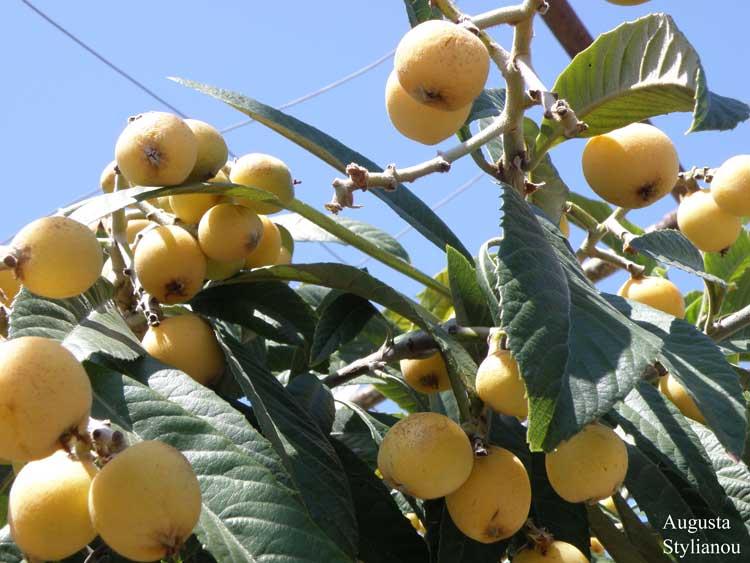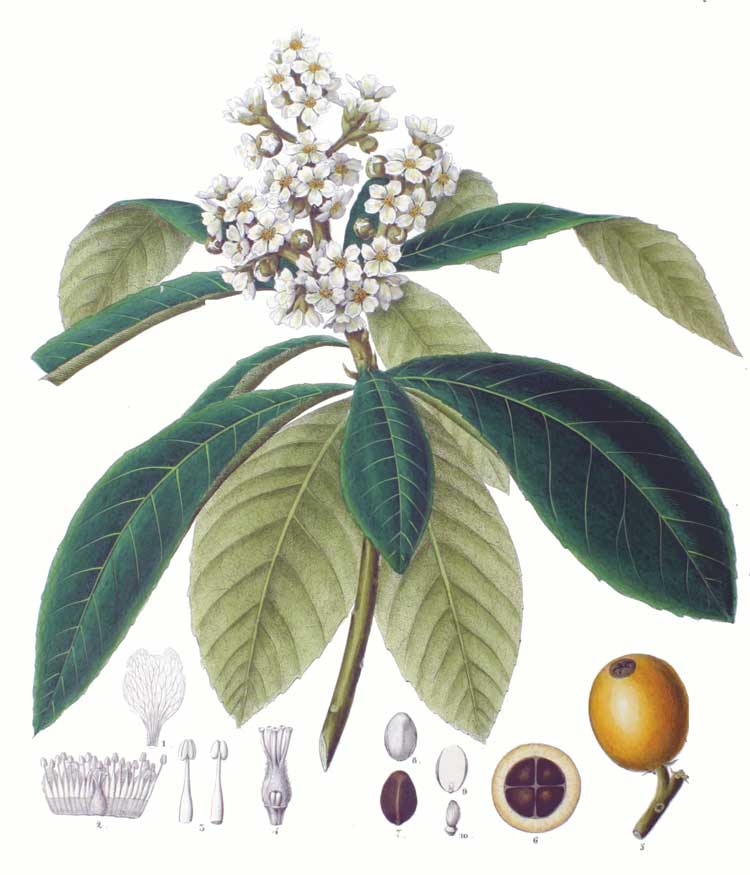Eriobotrya japonica , Photo: Augusta Stylianou Artist Cladus: Eukaryota Name Eriobotrya japonica (Thunb.) Lindl.
References * Transactions of the Linnean Society of London. London 13(1):102. 1821 Vernacular names The loquat (Eriobotrya japonica) is a fruit tree in the family Rosaceae, indigenous to southeastern China. It was formerly thought to be closely related to the genus Mespilus, and is still sometimes known as the Japanese medlar. It is also known as Japanese plum and as Chinese plum.
It is an evergreen large shrub or small tree, with a rounded crown, short trunk and woolly new twigs. The tree can grow to 5–10 m tall, but is often smaller, about 3–4 m. The leaves are alternate, simple, 10–25 cm long, dark green, tough and leathery in texture, with a serrated margin, and densely velvety-hairy below with thick yellow-brown pubescence; the young leaves are also densely pubescent above, but this soon rubs off. Loquats are unusual among fruit trees in that the flowers appear in the autumn or early winter, and the fruits are ripe in late winter or early spring. The flowers are 2 cm diameter, white, with five petals, and produced in stiff panicles of three to ten flowers. The flowers have a sweet, heady aroma that can be smelled from a distance. Loquat fruits, growing in clusters, are oval, rounded or pear-shaped, 3–5 cm long, with a smooth or downy, yellow or orange, sometimes red-blushed skin. The succulent, tangy flesh is white, yellow or orange and sweet to subacid or acid, depending on the cultivar. Each fruit contains five ovules, of which one to five mature into large brown seeds. The skin, though thin, can be peeled off manually if the fruit is ripe. The fruits are the sweetest when soft and orange. Use The loquat is comparable with its distant relative, the apple, in many aspects, with a high sugar, acid and pectin content. It is eaten as a fresh fruit and mixes well with other fruits in fresh fruit salads or fruit cups. Firm, slightly immature fruits are best for making pies or tarts. The fruits are also commonly used to make jam, jelly, and chutney, and are often served poached in light syrup. Loquat syrup is used in Chinese medicine for soothing the throat like a cough drop. The leaves, combined with other ingredients and known as pipa gao (枇杷膏; pinyin: pípágāo; literally "loquat paste"), it acts as a demulcent and an expectorant, as well as to soothe the digestive and respiratory systems. Loquats can also be used to make light wine. Like most related plants, the seeds (pips) and young leaves of the plant are slightly poisonous, containing small amounts of cyanogenic glycosides (including amygdalin) which release cyanide when digested, though the low concentration and bitter flavour normally prevents enough being eaten to cause harm. In Japan, it is eaten fresh or sometimes canned because the flesh is sweet. However, the waste ratio is 30% or more, due to the size of the seed. Among other things, it is processed to confectionery including jellies and the jam. Eaten in quantity, loquats have a gentle but noticeable sedative effect, with effects lasting up to 24 hours.[1] It is also fermented into a fruit wine, sometimes using just the crystal sugar and white liquor. Lemon or lemon zest is often paired with the wine because the fruit has very low acidity. Aficionados also enjoy a sake made exclusively from the seed, which has an aroma much like apricot kernel. Due to the presence of cyanogenic glycosides, bulk consumption may pose a risk of cyanide poisonings. History The Loquat is a fruit of Southeastern Chinese origin. It was introduced into Japan and became naturalised there in very early times, and has been cultivated there for over 1,000 years. It has also become naturalised in India, the whole Mediterranean Basin, Pakistan and many other areas. Chinese immigrants are presumed to have carried the loquat to Hawaii. The Loquat was often mentioned in ancient Chinese literature, such as the poems of Li Bai. In Portuguese literature, it is mentioned since before the Age of Discovery.[2] Production Japan is a leading producer of loquats (January to June) , followed by China (March to July). Cultivation The Loquat is easy to grow in subtropical to mild temperate climates where it is often grown as an ornamental tree, and second for its delicious fruit. The boldly textured foliage adds a tropical look to gardens, contrasting well with many other plants. There are many named cultivars, with orange or white flesh.[3] Etymology The name loquat derives from lou4 gwat1, the Cantonese pronunciation of its old classical Chinese name (simplified Chinese: 芦橘; traditional Chinese: 蘆橘; pinyin: lújú, literally "reed orange"). In modern Chinese, it is more commonly known as pipa (Chinese: 枇杷; pinyin: pípá), from the resemblance of its shape to that of the Chinese musical instrument pipa (琵琶). Likewise, in Japanese it is called biwa, similarly named from the corresponding musical instrument, biwa. It is also known as the "Japanese medlar", an appellation used in many languages: nêspera or magnório Also known As Ameixa in Brazil (Portuguese), níspero (Spanish), lokaat (Hindi), japanska mušmula or nešpula (Croatian), naspli (Maltese), nespola (Italian), náspolya (Hungarian), nespra (Catalan), nèfle du Japon or bibasse (French), L'meshmash (Algerian), néspera (Galician). Other names include: שסק sheseq (Hebrew), إسكدنيا Iskidunya, إكيدنيا Ik(k)idunya, Aki Dini,Igadinya or Bashmala بشملة (Arabic), Akkadeneh or Akka Dhuniya (Lebanese), mushmula or Nor Ashkhar (Armenian), mushmala (Georgian), mushmolla verore (summer medlar) (Albanian), μούσμουλο/μούσμουλα moúsmoulo/moúsmoula (sg/pl) or mespilia (Greek), Japanse (wol)mispel (Dutch), yeni dünya, muşmula or Malta Eriği in Turkish, mespila in Cyprus, mousmoula in Greece, despoles (δέσπολες) in Crete , Pibasy in Malagasy,мушмула (mušmulá) in Russian, and lukwart[4] in Afrikaans. The Armenian name Nor Ashkhar and the Turkish name yeni dünya literally mean "new world", while the everyday Turkish name for the fruit, Malta eriği, means 'Maltese plum', indicating perhaps confusion over the fruit's origin. Nutritional value The loquat is low in saturated fat and sodium, and is high in vitamin A, dietary fiber, potassium, and manganese.[5] Coppertone Loquat The Coppertone Loquat (Eriobotrya x 'Coppertone') is a cross between a loquat and an Indian Hawthorn [6] and is a popular shrub in the southern United States. See also * Kumquat (Although Kumquats are not related botanically to Loquats, the two names share an origin in their old Chinese names.) * Botanical and Horticultural Information on the Loquat (Traditional Chinese). External links References 1. ^ pfaf.org database Source: Wikipedia, Wikispecies: All text is available under the terms of the GNU Free Documentation License |
|


